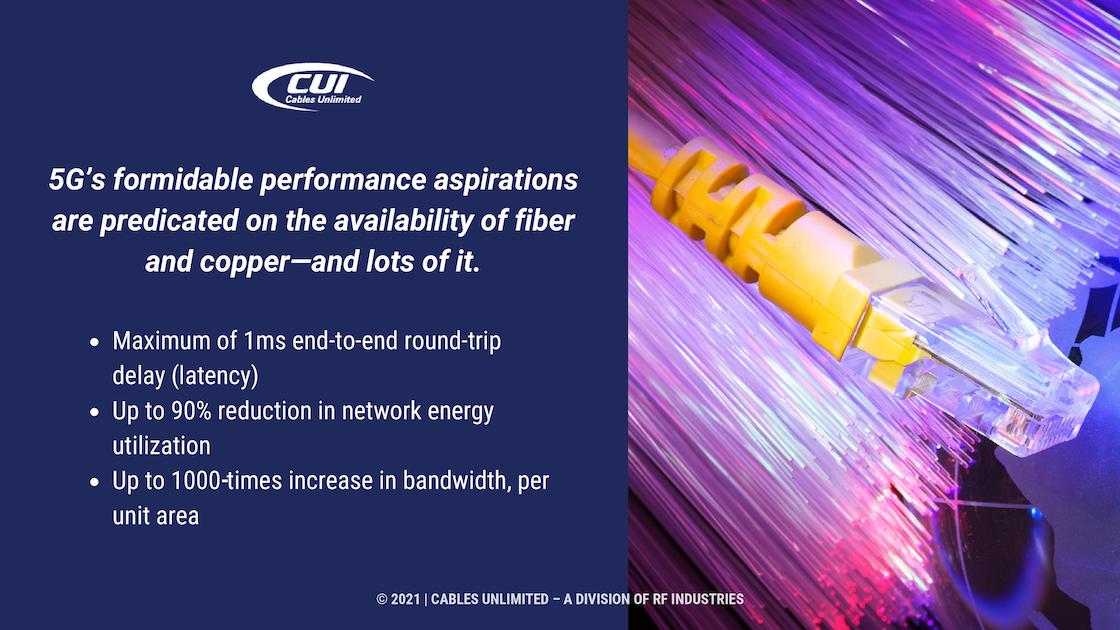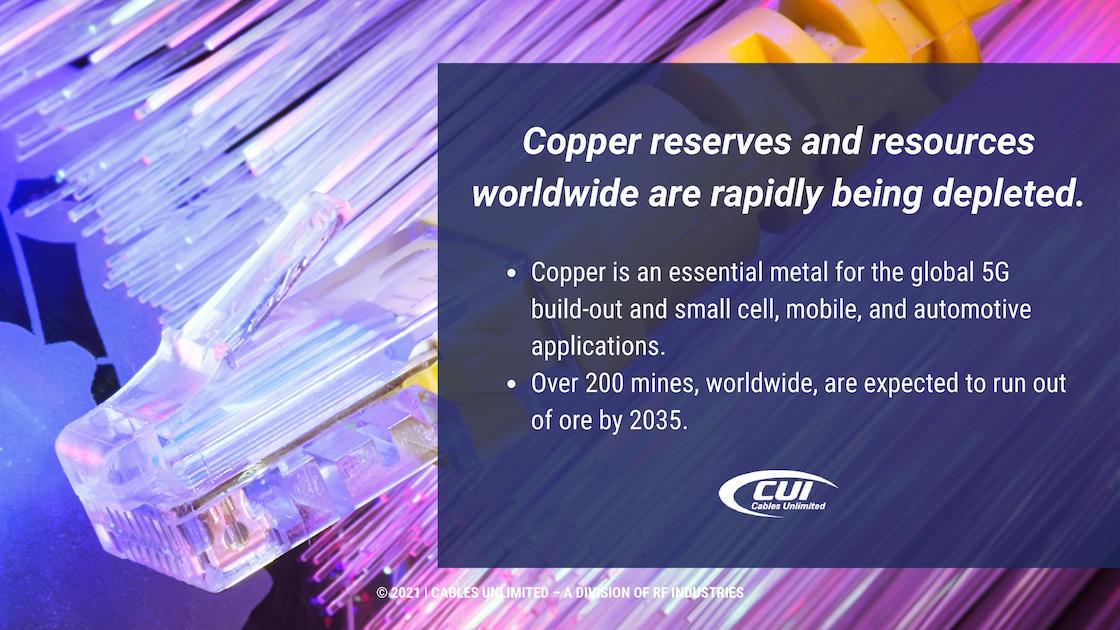A perfect storm is headed to the global network ecosystem. Only companies prepared to meet the surging demand for copper and fiber assemblies are ready for the onslaught. Expanding the 5G global infrastructure smoothly requires that companies are prepared and competent.
Cables Unlimited is uniquely qualified to meet your build deadlines at any quantity due to our extensive manufacturing competencies. Extensive quick-turn prototyping from CUI keeps your engineering team on schedule.
5G and Fiber Optics
5G communications will significantly affect both the wireless and wireline side of the global network infrastructure. 5G’s formidable performance aspirations are predicated on the availability of fiber and copper and lots of it.
- Maximum of 1ms end-to-end round trip delay (latency)
- Up to 90% reduction in network energy utilization
- Up to 1000 times increased in bandwidth, per unit area
COVID19 changed the world’s perception of broadband; no longer is it a luxury. Remote learning and work-at-home opportunities are necessities of life.
In 2020, more than 54 million homes were connected with fiber, growing a healthy 10% from the previous year. New Street Research has forecasted, the top eight telcos are ramping up production for 2021 and beyond.
If telecom successfully executes its plan in the coming decade, 20 to 60 million homes could see fiber broadband installed. This would mean FTTH in 25 to 35 percent of households.
In the United States alone, over 1000 smaller telecom players could add an additional ten million homes to the fiber buildout.
Deloitte considers the deployment of fiber optics as one of our nation’s deep imperatives. The buildout of 5G into our US network infrastructure is considered by many to be wholly dependent on fiber.
5G’s potential will fall significantly below expectations unless the United States significantly increases its deep fiber investments.
Cables Unlimited offers vast capacities of fiber optic cable for 5G network build-outs. Take advantage of CUI’s industry-leading “quick turn initiatives” to get your product in days, not weeks.

CUI’s Skilled Engineering and Support Teams have extensive experience with a wide array of cable configurations, connectors, and network components.
Our growing addiction to bandwidth, video-centric content, and a never-ending supply of connected devices has led to continuous network upgrades. Skyrocketing demand is driving fiber engineers to develop new optical technologies.
Engineering teams from CUI continually develop new, advanced fiber-optic innovations, allowing for a more versatile approach to connectivity.
The challenges are enormous for companies such as CUI. It is no easy task upgrading nearly 4 billion km of fiber installed since 1970.
Fiber to the Curb (FTTC): Insight Into Advantages and Applications
Copper Demand
Copper reserves and resources worldwide are rapidly being depleted, with mining companies scrambling to find new ore deposits. Copper is an essential metal for the global 5G build-out and small cell, mobile, and automotive applications.
Without extensive new capital investments, Commodities Research Unit predicts a shortfall of mined copper, from 20 million tons to under 12 Mt by 2034. Over 200 mines, worldwide, are expected to run out of ore by 2035.
Roskill reports by 2035, global copper consumption will exceed 43 million tons driven by GDP growth, urbanization, and electrical demand.
Read more in our blog: Copper Wires and Cables: History of Costs and the Coming Explosion of Demand
Cables Unlimited Manufacturing has the copper reserves to meet your build-out or technological needs. Your project can be placed on CUI’s Quick Turn Initiative, meaning the product can be delivered in days, not weeks.
According to KITCO, several economic drivers are the main cause of copper deficiencies:
- Construction wiring and piping
- Electrical transmission lines
- The move to electric vehicles (batteries, inverters, charging stations)
- Renewable energy, in particular, photovoltaic cells and wind turbines
- 5G build-outs; deployment involves a lot of copper and fiber

5G Global Infrastructure and the Connected World
5G has rapidly become foundational technology to the world’s largest and most influential enterprises.
Technology Upstarts and smaller network companies do not want to be pigeonholed into just legacy solutions. In their infancy, advanced network companies are selling value to consumers, and 5G is part of the ultimate value package.
5G and the digital world is about to become faster and broader, giving every industry on earth a boost. Thousands of the world’s largest companies will experience productivity and innovation with an enhanced digital backbone.
The connected countries of the world will see mobility, healthcare, manufacturing, and retail sectors drive Global GDP, by nearly $2 trillion by 2030. On top of this, two billion users from developing countries are set to come online, generating another $2 trillion in economic impact.




